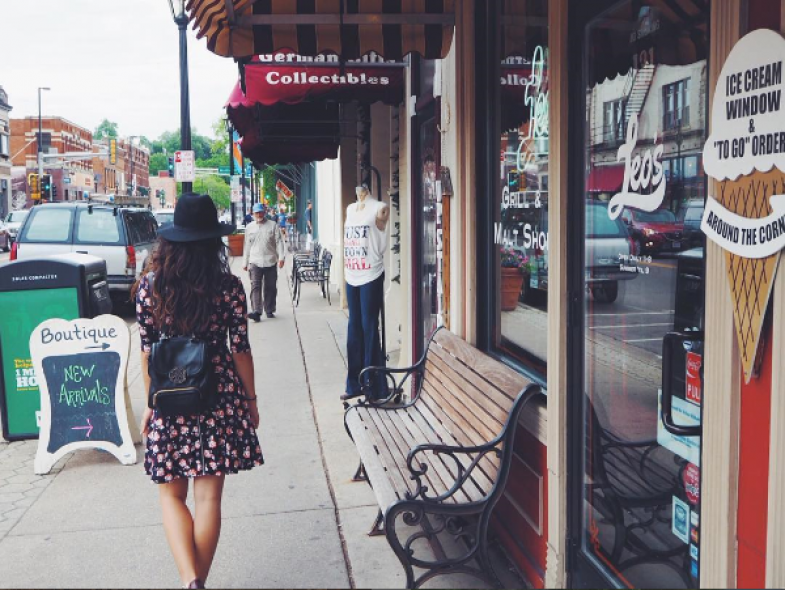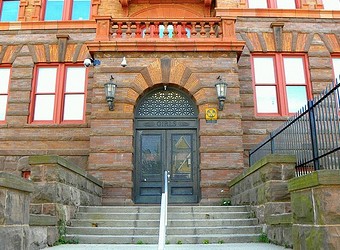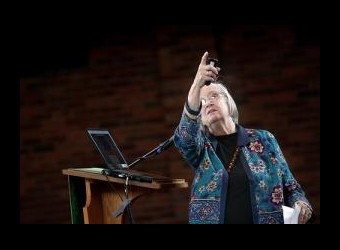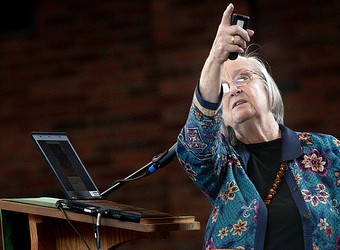Updated from the book All That We Share: A Field Guide to the Commons, published by The New Press
From the Fox News-Wall Street Journal-National Review Information Link—North American edition
SOUTH BEND, INDIANA (USA)—Posted: August 3, 2040 2:38 p.m.
Just a few years ago, the sight of downtown streets in South Bend thronged with shoppers, office workers and entertainment seekers would have been shocking. Once upon a time, you could shoot a cannon down South Bend’s Main Street at eight p.m. with little risk of casualties. But downtown is now bustling with people day and night, many who come not to work or shop but to be where the action is.
Over the past five years, 6800 new housing units have been built in the area, along with a spate of new offices, restaurants, bars, stores, theaters and galleries South Bend’s newly completed downtown farmers’ market complex draws tens of thousands of visitors each day, and Lafayette Street is referred to as the “Wall Street of Credit Unions”, with more than a dozen cooperatively owned financial institutions headquartered along a three-block stretch. One of these, the Mondragon American Trust, which popularized the concept of transforming suburban subdivisions into eco-villages, is now larger than all but two Wall Street banks.
As much as anywhere in the United States, South Bend has prospered by capitalizing on the promise of the commons—which means assets belonging to all of us, from water and wilderness to the Internet and cultural treasures. The commons also refers to a new ethic of sharing and cooperation that can help solve pressing problems of the 21st Century, advocates say This spirit has come to influence decision making at all levels in South Bend, bringing big changes to city hall, business offices and neighborhood groups.
While the ideas of the commons sound theoretical and abstract, commons-based policies show practical results. The South Bend unemployment rate hovers below 2 percent, and the city ranks high for the quality of its municipal services and the strength of its civic organizations. Because such a sizable share of economic activity rests in the hands of locally owned business and cooperatives, South Bend’s new wealth is spread around the community, not piped to a corporate headquarters far away. The last of the area’s six Walmart stores closed last year, while Amazon/Target/Home Depot/ IKEA/Gap announced layoffs last month accounting to 55 percent of their South Bend workforce. .
High school graduation rates are the highest ever in the city’s history, with 93 percent of students going on to college or technical training programs. The St. Joseph river and local lakes are clean enough for fishing and swimming. Three light rail lines, coupled with policies to promote bicycling and pedestrian-friendly neighborhood businesses, give the once-gritty city an almost Parisian quality of urban charm.
Stuck in the Past?
Even with the city’s impressive performance, some charge that South Bend is looking backward, paddling against the stream of economic progress that has powered human advancement and prosperity since the dawn of the industrial revolution.
B. Dietrich Campbell, former president of the South Bend Area Chamber of Commerce, thunders about the “inanity of those who put their faith in shimmering, shadowy ideas about cooperation and community, when it has been proven over and over that the privatized workings of an all-out market economy is the only way to stay above water in a competitive world. The gimmicks being tried today in our city will soon collapse, leaving us worse off than ever.”
Campbell, a fiery congressman from 1995 to 2019, was forced out of his position with the Chamber of Commerce six years ago, replaced by the owner of a family-run sporting goods store. This year, for the first time, the Chamber signed on as a cosponsor of South Bend’s famous Common Wealth Festival, which was launched fifteen years ago by local activists as a celebration of what South Bend residents share in common—from parks and arts organizations to local online communities and loyalty to the Notre Dame football team. Last year, the Common Wealth Festival attracted 800,000 visitors, making it the second-largest event in the state, behind the Indiana State Fair but ahead of the Indianapolis 500.
South Bend Mayor Lakeesha Kluzynski notes that per capita income is now higher in once dilapidated inner-city neighborhoods than in the suburban areas, where middle-class people fled to in the twentieth century. But she is quick to add, “We are doing a big push on affordable housing in the city. Lower-income people should not be segregated in the suburbs. We see the region as one unified community, and we make decisions based on what’s best for everyone. There is very little disparity on key measures of social well-being between wealthier districts and poorer ones. This is because of our dedication to the common good.”
“I don’t know of another place that has done a more thorough job of bringing government, community groups, nonprofit institutions, and private business together to solve pressing problems and make sure that future generations enjoy the bounty of the commons in their daily lives, declares Salaam Sanchez, director of the prestigious E.F. Schumacher School of Business at the University of Puerto Rico. “South Bend is pointing us in the direction of a sustainable, prosperous, and—dare I say—pleasurable future.
“A few die-hard market zealots still complain that all this emphasis on the commons is a retreat from human progress,” Sanchez adds. “But that only makes sense if you believe that progress inevitably means rising environmental disasters, increasing poverty, mounting social alienation and the commercialization of almost everything in our lives. Only a fool would accept those terms.”
As Goes South Bend, So Goes the Nation?
While South Bend has accomplished the most of any American community in promoting a vision of the commons—thanks to the enthusiastic work of citizens coming out of neighborhood organizations, social movements, labor unions, the business community and religious congregations—you see similar policies being put into action everywhere across North America, from Bangor to Berkeley, Ottawa to Oaxaca..
Nearby Gary, Indiana—once an economic basket case in anyone’s eyes—is now thriving as the center of the revived Lake Michigan fishing industry. Hard-hit Buffalo, New York, flourishes as the home of world-renowned green engineering firms. Even after the closing of its military bases, San Antonio is booming, thanks to its emergence as a music and media capital known as the Tex-Mex Hollywood.
Even stalwart Republicans now concede that measures to boost the commons represent a necessary correction to the reckless privatization of public assets that started with Ronald Reagan. intensified under George W. Bush, reaching ludicrous proportions during the Trump/Pence presidency. No one, not even on the farthest reaches of the American right, wants to put lobbyists back in charge of writing energy, economic, and environmental legislation.
“Those were dark days, which thankfully are now in the past,” declares Newt Gingrich III, president of the Theodore Roosevelt Institute (once known as the Heritage Foundation). “It was a huge mistake to equate belief in markets with obedience to corporations. Activists on the right can admit when we were wrong. But let’s remember that small, independent businesses, working with grassroots communities, have been the salvation of our country, and we intend to make sure that the balance of power does not tip too far in the direction of government. The public sector can do some things very well—but not everything.”
It’s significant that the first Republican elected to the White House in twenty four years was very careful to voice her support for a commons-based society at every campaign stop. After six months in office she has proposed no major changes to once controversial policies that mandated Community Impact Statements for all new development projects, launched a new “Marshall Plan for Local Economies” throughout the world, or granted national sovereignty to Native American tribes.
Of course, no political office holder today would dare attack overwhelmingly popular measures such as universal health insurance and free college tuition, paid for by user fees levied upon companies using commons resources, as well as the Children’s Trust Fund, which provides every native-born U.S. citizen at age thirty with $150,000 to invest, buy a home or start a business, paid for by a service fees on all stock market transactions.
A Cultural Revolution Hits Home
Political action, of course, represents only part of the overall thrust of the commons. Probably the greatest impact has come in the flowering of community and civic organizations dedicated to improving people’s lives. Rev. Peggy Chang, a bestselling self-help author and Southern Baptist minister, , notes, “From the rise of shared-family housing to the teen service corps and the creation of new neighborhood plazas in almost every town, the commons brightens our lives from morning to midnight. It amounts to a spectacular shift from ‘me’ to ‘we.’”
Indeed, the daily rhythm of modern society has evolved dramatically since the harried days when demands of the market economy drove almost every aspect of life. Chang exults over the changes: “The long working hours, financial anxiety and lack of time for family, fun, friends and faith seem like a bad dream now. The rediscovery of the commons prompted people to think more about what really mattered to them.”
Libertarian Paradise Lost
This cultural shift can be seen most vividly in a town like Cato, Texas. If you were looking for a place that once stood as the antithesis of a commons-based society, Cato would be it. This outer-ring suburb of Houston, founded as a gated community in 2004, gained widespread media attention for its almost complete lack of government services. The local water utility was a subsidiary of the Bechtel Corporation, and nearly all the community’s children attended private academies. Even the police department was run as a for-profit business, with different levels of protection available to households depending on how much in premiums they paid to a private security company. (Some lower-cost plans, for instance, did not cover house calls for nuisance crimes, burglaries, or domestic disputes.)
Cato never attracted anywhere near the 125,000 residents projected by its developers. Today, the population stands at 4200, down from about 11,000 in 2020. At one point there was serious discussion about leveling the place to create community gardens, but the town got a reprieve in 2028 when a station on Houston’s expanding commuter tube rail system opened. The real turn around began, however, with the formation ten years ago of People United to Build a Livable Cato (PUBLIC).
Buffy Ayn Beauchamp, one of PUBLIC’s instigators, recalls, “At that time, all anyone could talk about was what’s wrong with Cato—no sidewalks, no parks, no locally owned businesses, no one who knew their neighbors. No there there. And truthfully, it was hard to look beyond the endless strip malls, six-lane streets with roaring traffic, and shabby McMansions with rust streaks on the vinyl siding. But this community had some good things going for it too, namely that a lot of people living here were willing to roll up their sleeves to make things better.”
Meeting weekly in the back room of a coffee shop, PUBLIC drafted an ambitious agenda to tackle the town’s problems. A baby-sitting co-op, mentoring programs, neighborhood tool exchanges, carsharing club, Mardi Gras parade and annual harvest festival were the first orders of business of this hard-charging organization. Then came the new park, public school, recreation center, and recycling depot—all funded by federal grant money but built mainly by local volunteers. The site of a vacant mall was fashioned into a Main Street, and a Latino cultural center now occupies an Old Navy store. Local churches spearheaded construction of a community-owned grocery, café, hardware store, fitness center, and cantina. The Houston Park District took over management of the country club, opening it to the public.
Strolling through the community on a spring evening, when the temperature has cooled to the mid- nineties, there are few reminders the town began as an experiment in creating a privatized Utopia. Indeed, historical preservationists lost the battle to save the statue of economist Milton Friedman that stood next to the now demolished guardhouse at the town’s main entrance, where today you’ll find a memorial to victims of the Great Texas Heat Wave of 2031.
The Commons Goes Global
It astounded people around the globe—including many in the USA—that over the past decade most Americans have gradually come to think of themselves as “commoners.” While Canada had social democratic sensibilities to build upon and Mexico benefited from indigenous and peasant traditions that kept the spirit of the commons alive, the United States was long guided by the ideals of rugged individualism. No country believed more fervently in privatization and extremist market economics, no matter what the social cost. But over the past 15 years, the country’s cultural landscape has been reshaped and Americans have wholeheartedly embraced the principles of commoning—a network of informal exchanges and sharing that characterize community life today.
So what happened?
Scholars, pundits, and everyday citizens offer many theories, all of which credit the disastrous presidency of Donald Trump and the rise of the digital commons. The digital commons that flourished after stringent net neutrality and tech industry anti-trust laws were passed in 2021 also gave Americans opportunities to make closer contact with people in other countries, gaining exponentially more knowledge about what was happening around the globe. Ordinary citizens in places like South Bend and suburban Houston learned that all European nations had better—and less expensive—health care than we do. They learned that Ecuador’s national constitution protected the rights of ecosystems. They were shocked to discover the “workaholic” Japanese spent fewer hours on the job each year than Americans and enjoyed more vacation.
This learning process intensified into action during the 2030s of the century as the ideas of the commons took hold globally. Indigenous people’s successful claims for national autonomy in Brazil and Australia fueled similar efforts from the Yukon to the Yucatán. The “Free the Streets” movement that erupted first in China, then Jamaica, and Los Angeles inspired citizens to organize for massive reductions in automobile traffic—including electric and autonomous vehicles, which are just as destructive to community life as gas-guzzling SUVs. The radical re-envisioning of patent and copyright laws pioneered in Korea was adopted in North America.
No great idea about how to improve our lives stayed in one place for long. Wilderness restoration practices pioneered in Madagascar took root across the Northern Hemisphere. Denmark’s savvy strategies to care for an aging population were soon implemented throughout industrialized nations. The Common Wealth Festival dreamed up in Karachi, Pakistan, was imitated in South Bend, Pretoria and hundreds of other places.
“Democracy took a great stride forward with the rise of the global commons,” declares Fernanda Vasconcellos Ruiz, an outspoken librarian who became governor of the Mexican state of Jalisco. “Suddenly people had access to unlimited information, which before had always been controlled by the experts, the media and the politicians. Now, a plumber or a schoolteacher could propose a solution with the same expertise and data as a big shot. It inaugurated a new epoch of citizenship, with very positive results for the common man and woman.”
The widening reach of global communications also—paradoxically—ignited people’s passion for locally-rooted culture. Hussein “Mahatma” Usmani, founder of the Karachi Common Wealth festival and now UN Commissioner for Commons Development, notes, “The hallmark of our era is that people have one foot in the wider world and one foot firmly planted in their own community. We live in the “Glocal Age,” when people can enjoy the best of what’s global and what’s local.
“I think this is why we are experiencing fewer armed conflicts and terror campaigns these days, even as we cope with the ordeals of water shortages,” Usmani continues. “The strong instincts all humans possess for group identification are now channeled into their own region or city, rather than into abstract allegiances like Pakistan or India Muslim or Hindu or Christian. It’s much healthier for us to fiercely believe that our local football team is the best or that our cheese tastes better than what’s eaten in the next valley.”
Around-the-World in Your Own Backyard
The glocal spirit of the commons is on full display here at the Common Wealth Festival in South Bend, which opened last night. At the TED Bazaar, folks are urged to download the latest movies, music, blogs, software, greenware, smartware, slowware, poetry, architectural codes, news reports, video mash-ups, engineering specs, gaming templates, typographical styles, and fashion designs from everywhere across the planet. At the same time, festivalgoers can sample 75 different beers, 40 wines, 13 bourbons, 31 vinegars, 116 cheeses, 56 different kinds of sausage and 8 varieties of West African-style cassava brew, all made right inside the county line.
“South Bend is the center of the universe—to those of us who live here,” exclaims Mayor Lakeesha Kluzynski, who admits to liking the Polish sausages best. “That’s the great gift of the commons—letting us discover the wonderful things around us that we all share.”












